Drancy
Drancy (French pronunciation: [dʁɑ̃.si]) is a commune in the northeastern suburbs of Paris in the Seine-Saint-Denis department in northern France. It is located 10.8 km (6.7 mi) from the center of Paris.
Drancy | |
|---|---|
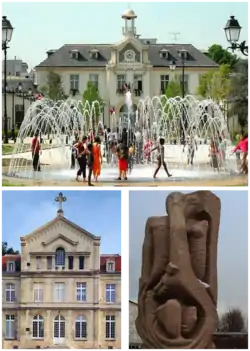 From upper left: City Hall, Castle of Ladoucette, National Memorial of Deportation | |
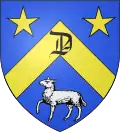 Coat of arms | |
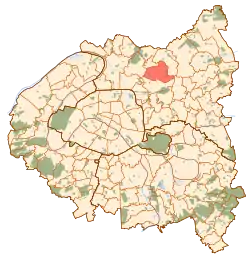 Paris and inner ring departments | |
Location of Drancy 
| |
 Drancy Paris and inner ring departments 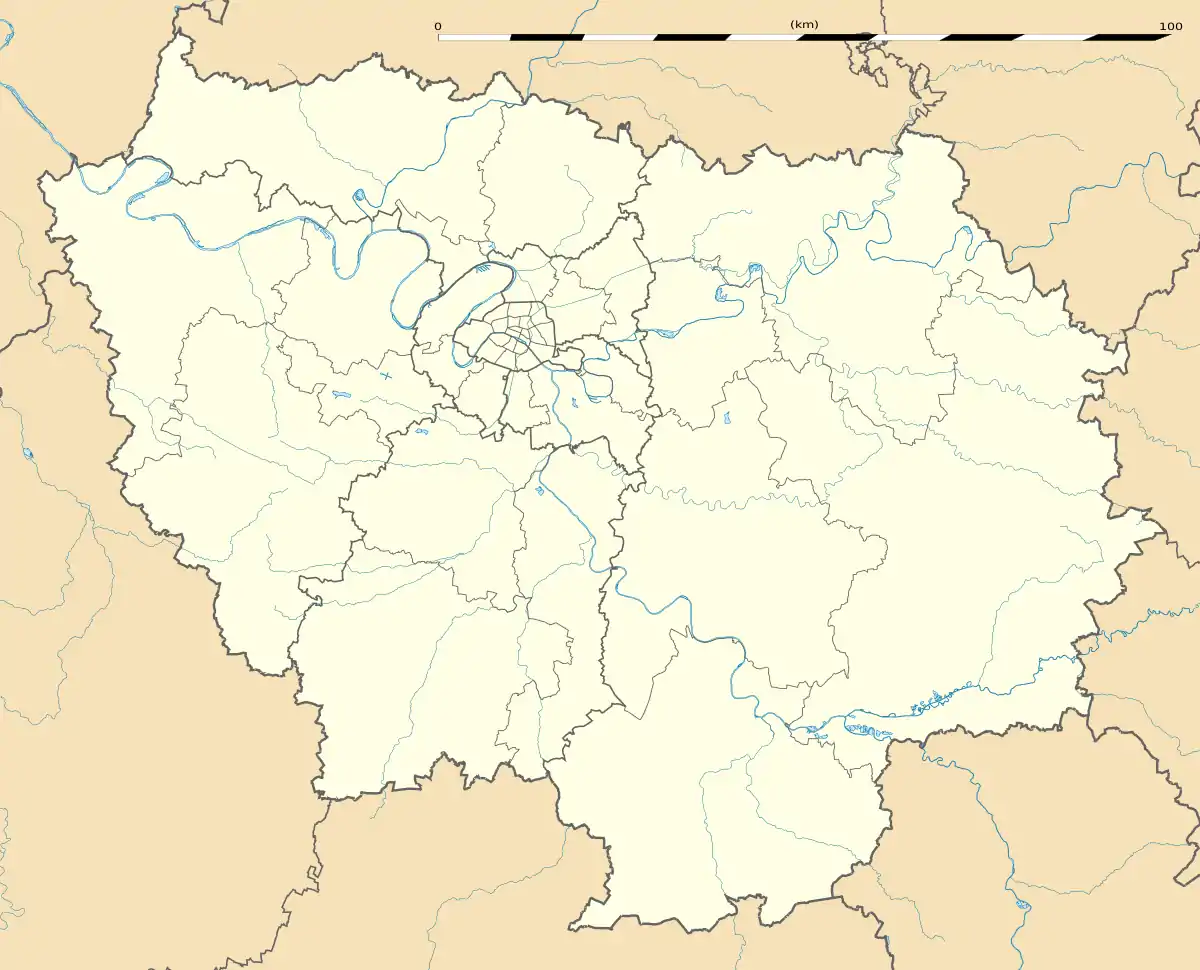 Drancy Drancy (Île-de-France (region)) | |
| Coordinates: 48°56′N 2°27′E | |
| Country | France |
| Region | Île-de-France |
| Department | Seine-Saint-Denis |
| Arrondissement | Le Raincy |
| Canton | Drancy and Le Blanc-Mesnil |
| Intercommunality | Grand Paris |
| Government | |
| • Mayor (2020–2026) | Aude Lagarde[1] |
| Area 1 | 7.76 km2 (3.00 sq mi) |
| Population (2017-01-01)[2] | 71,318 |
| • Density | 9,200/km2 (24,000/sq mi) |
| Time zone | UTC+01:00 (CET) |
| • Summer (DST) | UTC+02:00 (CEST) |
| INSEE/Postal code | 93029 /93700 |
| Elevation | 39–54 m (128–177 ft) |
| 1 French Land Register data, which excludes lakes, ponds, glaciers > 1 km2 (0.386 sq mi or 247 acres) and river estuaries. | |
History
Toponomy
The name Drancy comes from Medieval Latin Derenciacum, and before that Terentiacum, meaning "estate of Terentius", a Gallo-Roman landowner.
Origins to 20th century
In the 17th century, Drancy was divided into two distinct villages: Drancy le Grand and le Petit Drancy. The quarter "Village Parisien" is built on the old location of the hamlet of Groslay which was surrounded by the forest of Bondy—hence the name of rue des Bois de Groslay.
The end of nineteenth century was marked by the industrialisation and by the development of rail transports. During the Franco-Prussian war, Le Bourget was the site of an important battle and the castle of Ladoucette in Drancy was destroyed.
20th and 21st centuries
During World War II, Drancy was the site of the Drancy internment camp where Jews, Gypsies, and others were held before being shipped to the Nazi concentration camps. In 1976, the Memorial to the Deportation at Drancy was created by sculptor Shlomo Selinger to commemorate the French Jews imprisoned in the camp.
Population
|
|
Immigration
| Born in Metropolitan France | Born outside Metropolitan France | |||
|---|---|---|---|---|
| 75.0% | 25.0% | |||
| Born in Overseas France |
Born in foreign countries with French citizenship at birth1 | EU-15 immigrants2 | Non-EU-15 immigrants | |
| 2.1% | 2.2% | 6.1% | 14.6% | |
| 1 This group is made up largely of former French settlers, such as pieds-noirs in Northwest Africa, followed by former colonial citizens who had French citizenship at birth (such as was often the case for the native elite in French colonies), and to a lesser extent foreign-born children of French expatriates. Note that a foreign country is understood as a country not part of France in 1999, so a person born for example in 1950 in Algeria, when Algeria was an integral part of France, is nonetheless listed as a person born in a foreign country in French statistics. 2 An immigrant is a person born in a foreign country not having French citizenship at birth. Note that an immigrant may have acquired French citizenship since moving to France, but is still considered an immigrant in French statistics. On the other hand, persons born in France with foreign citizenship (the children of immigrants) are not listed as immigrants. | ||||
Heraldry
 arms of Drancy |
The arms of Drancy are blazoned : Azure, on a chevron Or a gothic letter 'D' sable at its summit, between two mullets and a sheep passant argent. |
Geography and cityscape
Climate
| Month | Jan | Feb | Mar | Apr | May | Jun | Jul | Aug | Sep | Oct | Nov | Déc | Year |
|---|---|---|---|---|---|---|---|---|---|---|---|---|---|
| Average low °C | 0,9 | 1,3 | 2,9 | 5 | 8,3 | 11,2 | 12,9 | 12,7 | 10,6 | 7,7 | 3,8 | 1,7 | 6,6 |
| Average °C | 4 | 4,5 | 7,3 | 9,7 | 13,7 | 16,5 | 18,9 | 18,8 | 15,5 | 11,5 | 7 | 5 | 11,9 |
| Average high °C | 6 | 7,6 | 10,8 | 14,4 | 18,2 | 21,5 | 24 | 23,8 | 20,9 | 16 | 10,1 | 6,8 | 15 |
| Precipitation mm | 54.3 | 46.1 | 53.5 | 46.5 | 63.3 | 57.8 | 53.6 | 51.6 | 53.8 | 55.5 | 55.8 | 55.6 | 647.3 |
| Sunshine hours | 55.6 | 87.5 | 129.4 | 172.8 | 201.4 | 218.8 | 239.1 | 221.1 | 173.3 | 125.8 | 75.2 | 50.6 | 1749.5 |
Architecture
Drancy's buildings are too diverse to be characterised by any particular architectural style. Some of them with a style Art Nouveau are typical of the 19th and 20th centuries. There are housing estates and a garden city.
Park and Castle of Ladoucette
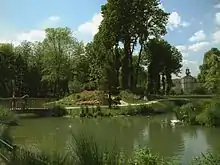
The parc de Ladoucette[5] is the only park of Drancy. It contains a pond, a small educational farm and the castle of Ladoucette. The castle was built in 1533 by Pierre Séguier. In the 19th century, the castle was the property of the senator Charles-Loetitia de Ladoucette. In 1874 his wife, la Baronne de Ladoucette, died and her body was placed in the Mausoleum de la Baronne de Ladoucette. Today she is buried in the Parisian cemetery.
Administration
Part of the commune forms the canton of Drancy. The other part belongs to the canton of Le Blanc-Mesnil.
Transport
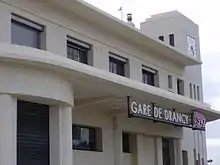
Railways and buses
Drancy is in Zone 3 of the Carte orange. The city is served by Le Bourget station and by Drancy station on Paris RER line B. Le Bourget station is situated near Drancy as well as the metro station La Courneuve 8 mai 1945 on line 7.[6] The RER B is one of the five lines in the RER Rapid transit system serving Paris and its suburbs.
Drancy is also served by the Paris Tramway Line 1 with five stops[7] and by twelve buses.
By the RER B, Drancy is near many parisian railway stations, Gare du Nord is now just 10 minutes away, gare Saint-Lazare and gare de Lyon can be reached in 30 minutes. Charles de Gaulle Airport can be reached in 30 minutes too.
Education
Schools:[8]
- 17 public preschools (écoles maternelles)
- 19 public elementary schools
- Six public junior high schools (collèges): Paul Bert, Anatole France, Jorissen, Paul Langevin, Liberte, Pierre Samard
- One private junior high school, Collège Saint-Germain
- Two public senior high schools/sixth-form colleges: Lycée Eugène Delacroix and Lycée Paul le Rolland
References
- "Répertoire national des élus: les maires". data.gouv.fr, Plateforme ouverte des données publiques françaises (in French). 2 December 2020. Retrieved 7 December 2020.
- "Populations légales 2017". INSEE. Retrieved 6 January 2020.
- "Site de météorologie et de climatologie". http://www.lameteo.org/ (in French). Archived from the original on 2011-07-27. External link in
|work=(help) - "Site de climatologie et de météorologie". infoclimat.fr/accueil/ (in French).
- Nicolas Grenier, french poet, has written a poem about this parc de Ladoucette
- "Site de la RATP - Drancy-Le Bourget" (in French).
- "Site de la RATP - Le tramway 1" (in French).
- "Education." Drancy. Retrieved on September 6, 2016.